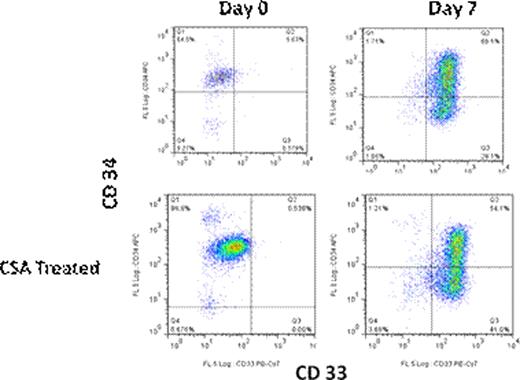Abstract
Abstract 4833
NFAT1 (NFATc2) transcription factor is known to modulate allogeneic T-cell mediated immune responses in the post transplant setting by affecting release of bioactive cytokines such as IFN- γ and IL-2 from donor CD4+T-Cells. Cyclosporine-A (CSA) inhibits NFAT1 activation via the phosphatase-Calcineurin and has been shown to be effective in prophylaxis and treatment of graft versus host disease (GVHD). However, little is known of the role of NFAT1 transcription factor and its inhibition, in affecting differentiation and proliferation of CD34+ Hematopoietic Stem Cells.
Mononuclear cells (MNC) were prepared using Ficoll Paque density gradient method from human cord blood (Umbilical Cord blood Units kindly provided by Dr. Pablo Rubinstein, MD, New York Blood Center). These MNC's were enriched for CD34+ HSC using magnetic bead separation (Auto Macs, Miltenyi). The resulting purity of HSC routinely exceeded >90%. This CD 34 + cell population was seeded at a density of 60,000 cells/ml in 12 well plates in CellGenix (serum free media) supplanted by the following cytokines: IL-3 (5ng/ml), FLT-3L (100 ng/ml), SCF (50 ng/ml), G-CSF (30 ng/ml) and GM-CSF (5ng/ml). Cells were cultured under normoxic conditions for 7 days at 37.0C with 5% CO2 either in the presence or absence of CSA at concentration 2μM. We examined cell proliferation and differentiation by the following cell surface markers- CD34/CD33/HLA-DR/CD71/ and CD14. Cell counts were enumerated (Coulter) at baseline, day 2, 5, 7 and multiplied by FACS proportions to calculate absolute numbers of specified cell populations. Experiments were conducted with and without CSA in culture media, a known inhibitor of NFAT1 dephosphorylation. Cells were harvested on Day 0, 2, 5 and 7.
Flow cytometry analysis of CD 34 + cells grown in absence of CSA showed progressive decline of CD34 expression over days 2, 5 and 7 and progressive increased in CD33 and HLA-DR surface expression. In the presence of CSA however, we saw a rapid rise of CD33 (41.0% versus 28.1%), HLA-DR (44.4% versus 29.1%) and CD 71 (24.4% versus 12.7%) cell fractions on Day 7, compared to culture conditions when CSA was absent., No difference was noted in total cell count in CSA treated (701,666.6 ± 7637 (Mean and SD))and untreated (643,333 ± 5166 cells) conditions in culture by Day 7.
The above results suggest that inhibition of NFAT1 signaling in CD34+ HSC using CSA results in more rapid differentiation towards the myelomonocytic and erythrocytic lineages as seen by flow cytometry. This data suggests that NFAT1 may participate in hematopoietic differentiation of CD34 progenitors in these cytokine conditions, and further that loss of NFAT1 signaling may allow enhanced kinetics of differentiation of CD34 + HSC towards myelomonocytic and erythroid lineages. Further understanding of NFAT1 regulation of normal HSC may have implications for routine CSA administration in patients undergoing allogeneic transplantation as well as potential role in myeloid malignancies resulting from NFAT1 dysregulation.
Farrow Fellowship Award
No relevant conflicts of interest to declare.
Author notes
Asterisk with author names denotes non-ASH members.




